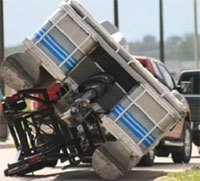What you should know about Center Lift Pontoon Trailers
 |
 |
||||||||||||
We are frequently asked to
make recommendations on
center lift pontoon
trailers. Our standard
response is that for most
applications we recommend
the wide axle stance of our
bunk style trailer.
However, there are
applications for the center
lift style trailers.
Neighbors sometimes want
center lift pontoon trailers
so that the trailer can be
used on more than one
pontoon boat. There are some
lakes with very poor-shallow
ramps where it’s almost
impossible to launch from an
ordinary trailer. There are
storage concerns where
individuals want to fit
their pontoon boat in a
garage or building with a
low overhead door, etc.
These are all valid reasons
for considering a center
lift pontoon trailer.  However
these considerations must be
weighed against the
potential danger of the
center lift pontoon trailer.Center lift trailers can be very tippy. That means that if you clip a curb with a tire or a sudden gust of wind hits the boat and trailer, the whole load can tip over. Thousands of pontoon boats have gone down the road safely on center lift trailers, but the potential for danger is always present. The modern pontoon boat with extensive furniture layouts, 30+ gallon gas tanks and heavier engines increases the potential for weight distribution problems on a center lift narrow axle wheel base pontoon trailer. However
these considerations must be
weighed against the
potential danger of the
center lift pontoon trailer.Center lift trailers can be very tippy. That means that if you clip a curb with a tire or a sudden gust of wind hits the boat and trailer, the whole load can tip over. Thousands of pontoon boats have gone down the road safely on center lift trailers, but the potential for danger is always present. The modern pontoon boat with extensive furniture layouts, 30+ gallon gas tanks and heavier engines increases the potential for weight distribution problems on a center lift narrow axle wheel base pontoon trailer. |
|||||||||||||
|
|||||||||||||
|
The lower the center of gravity, the more stable the center lift pontoon trailer will be. Box frame pontoon trailers that transfer the weight of the pontoon boat to a lower frame are more stable than pipe frame pontoon trailers. Some brands of pipe frame pontoon trailers have the center of gravity 3’ off the ground, and are very tippy. On box frame trailers, look for transfer arms to be straight up and down when the frame is in the up position. These arms transfer the weight of the pontoon boat from the top frame to the bottom. Arms that are not straight up and down when the trailer is in the up position will not transfer the weight properly to the lower frame. The more weight transferred to the lower frame, the less tippy the boat and trailer will be. Some center lift pontoon trailers have arms that are at a 30 degree angle. In our opinion, this is a design defect. With the lifting arms at an angle, not only to they not transfer the weight properly, they place unnecessary stress on the cable and winch when in the up position. |
|||||||||||||
|
For Information Call (877)294-3395 or (574)294-3386 |
|||||||||||||








